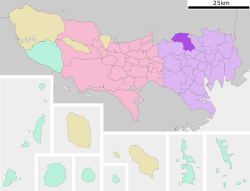Itabashi-ku, Tokyo
|
Itabashi 板橋区 |
||
|---|---|---|
| Special ward | ||
| Itabashi City | ||

The east exit of Itabashi Station
|
||
|
||
 Location of Itabashi in Tokyo Metropolis |
||
| Location in Japan | ||
| Coordinates: 35°46′N 139°41′E / 35.767°N 139.683°ECoordinates: 35°46′N 139°41′E / 35.767°N 139.683°E | ||
| Country | Japan | |
| Region | Kantō | |
| Prefecture | Tokyo Metropolis | |
| Government | ||
| • Mayor | Takeshi Sakamoto (since April 2007) | |
| Area | ||
| • Total | 32.22 km2 (12.44 sq mi) | |
| Population (May 1, 2015) | ||
| • Total | 547,270 | |
| • Density | 16,990/km2 (44,000/sq mi) | |
| Time zone | Japan Standard Time (UTC+9) | |
| City hall address | Itabashi 2-66-1, Itabashi-ku, Tokyo 173-8501 |
|
| Website | www |
|
Itabashi (板橋区 Itabashi-ku?) is a special ward located in Tokyo Metropolis, Japan. In English, it calls itself Itabashi City. Itabashi has sister-city relations with Burlington, Ontario in Canada; Shijingshan District in Beijing, People's Republic of China; and Bologna in Italy.
As of May 1, 2015, the ward has an estimated population of 547,270 and a population density of 16,990 persons per km². The total area is 32.22 km².
Itabashi lies on the Kantō plain. The Arakawa River, a major river, forms part of the boundary with Saitama Prefecture. Surrounding the ward are, in Saitama, the cities of Wako and Toda; and in Tokyo, the wards of Nerima, Toshima, and Kita.
The name of the ward means "plank bridge" and derives from the wooden span over the Shakujii River that dates from the Heian period. Such a bridge was remarkable at the time, and the name has lasted since. In the Edo period, the Nakasendō crossed the nearby Shimo Itabashi, and the name came to apply to that area as well. Itabashi was one of the Four Edo Post Towns, and travellers first lodged there after leaving the shogunal capital. The Kaga domain had a mansion there. The shogunate maintained the Itabashi execution grounds at Itabashi.
...
Wikipedia


